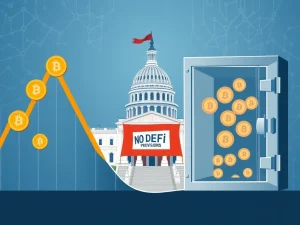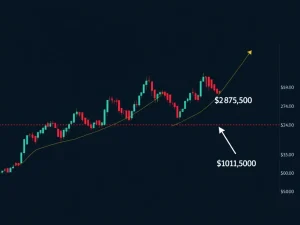Bitcoin Price: Crucial Crossroads After Weak US Jobs Data Sparks Uncertainty

The cryptocurrency market often reacts sharply to macroeconomic shifts, and recent events highlight this volatility. Indeed, the Bitcoin price has experienced significant fluctuations following the latest US jobs data release. Traders and investors now grapple with a critical question: is it time to embrace risk or retreat? This comprehensive analysis explores the factors driving Bitcoin’s recent movements, delving into both economic indicators and intricate on-chain metrics.
Weak US Jobs Data Rattles the Crypto Market Analysis
Earlier this week, Bitcoin (BTC) demonstrated robust upward momentum, surging by as much as 4.75%. This rally propelled the Bitcoin price from approximately $109,250 to a peak of $113,384. This bullish trend extended right up to the release of the highly anticipated US Nonfarm Payrolls (NFP) report on Friday. However, the subsequent data significantly diverged from expectations, triggering an immediate market reaction.
The August NFP report revealed a disappointing addition of only 22,000 jobs. This figure starkly contrasted with forecasts predicting 75,000 new jobs and July’s revised print of 73,000. Furthermore, the unemployment rate modestly increased to 4.3%, aligning with expectations but still higher than July’s 4.2%. Wage growth also showed signs of deceleration, slowing to 3.7% year-over-year from 3.9%. Consequently, these figures paint a picture of a cooling labor market, a scenario that carries profound implications for risk assets like Bitcoin.
For the crypto market analysis, weaker labor market data generally strengthens the argument for potential Federal Reserve rate cuts. Current probabilities for Fed rate cuts stand at a significant 88.2%, suggesting that the market widely anticipates such a move. This report, therefore, underscores a broader trend of cooling inflationary pressures. Moreover, it increases the likelihood of future liquidity injections by the central bank. Historically, lower interest rates and a weakening US dollar often serve as powerful tailwinds for the broader crypto market analysis and digital assets.
On-Chain Metrics Signal Shifting Sentiment
Interestingly, on-chain metrics provided early indications that market participants were preparing for potential volatility even before the official jobs report. Stablecoin inflows into cryptocurrency exchanges witnessed a substantial surge, exceeding $2 billion. This influx suggests that traders actively moved liquidity to the sidelines, essentially creating a pool of ‘dry powder’ ready for deployment. Historically, such significant stablecoin activity often precedes major price movements, as capital waits for a clear catalyst to rotate into assets like BTC and ETH.
Stablecoin exchange netflow. Source: CryptoQuant
Simultaneously, Bitcoin’s open interest climbed above $80 billion, reaching near all-time highs. This occurred despite the Bitcoin price consolidating around the $110,000 level. High open interest, especially during periods of price stability, indicates a significant buildup of leveraged positions rather than an unwinding. This phenomenon points to increased speculation and a readiness among traders to capitalize on anticipated price swings. The convergence of easing macroeconomic pressures and bullish on-chain metrics effectively sets the stage for heightened volatility, yet the underlying structural bias appears to lean upward. With liquidity primed and sentiment potentially shifting towards a ‘risk-on’ environment, Bitcoin could be preparing to establish a firm bottom and initiate its next significant upward trajectory.
Bitcoin Price Action: Immediate Reversal and Key Levels
Despite the initial positive reaction to the weaker-than-expected NFP print, the Bitcoin price trajectory quickly reversed. Immediately following the New York session open, BTC slid by 1.5%. This abrupt drop pushed Bitcoin back below the crucial $111,000 mark. It occurred after the asset had retested a key supply zone, specifically between $112,500 and $113,650. These intraday pullbacks are common occurrences in volatile markets.
Such rapid reversals often result from early long liquidations, with over $63 million in leveraged positions reportedly erased within a mere four hours. Furthermore, market makers frequently engage in ‘stop-hunting,’ capitalizing on crowded positioning to trigger stop-losses before potentially resetting the trend direction. Examining the one-hour chart, however, reveals a still-constructive structure for the Bitcoin price. Despite the recent setback, Bitcoin continues to form higher highs and higher lows, a classic indicator of an underlying uptrend. Unless BTC decisively closes below $109,500, the short-term bullish structure remains intact. The recent dip, therefore, appears more akin to a liquidity sweep rather than a genuine shift in the overall trend.
Bitcoin one-hour chart. Source: Crypto News Insights/TradingView
Federal Reserve and Broader Market Outlook
Zooming out to higher time frames presents a more cautious perspective on the Bitcoin price. With only two days remaining until the weekly close, it is premature to definitively declare a confirmed market bottom. A decisive weekly close above the $112,500 resistance level would significantly strengthen the argument that a durable base has formed near $107,500. Until this confirmation occurs, the broader crypto market analysis remains in a transitional phase. It balances macro-driven optimism, primarily stemming from expectations of Federal Reserve rate cuts, against local supply pressures and technical resistance levels.
Bitcoin one-day chart. Source: Crypto News Insights/TradingView
The potential for Federal Reserve policy shifts plays a pivotal role in this delicate balance. Should the Fed indeed move towards rate cuts, it would inject substantial liquidity into the financial system. This action typically benefits risk assets, including cryptocurrencies. Conversely, any hawkish signals from the Fed could quickly dampen enthusiasm. Therefore, monitoring central bank communications remains paramount for informed decision-making in the crypto space. The current environment highlights the intricate dance between monetary policy, economic data, and market sentiment.
Navigating Risk: The Road Ahead for Bitcoin Price and On-Chain Metrics
Ultimately, the question of whether to go ‘risk on’ or ‘risk off’ hinges on a careful evaluation of these converging factors. The lower-timeframe bias for the Bitcoin price currently leans bullish, supported by resilient chart structures. However, confirmation of a lasting market bottom requires a decisive weekly close above key resistance levels. Traders should closely monitor the $112,500 mark as a critical indicator. A sustained breach and hold above this level would signal renewed strength and conviction among bulls.
Furthermore, continued monitoring of on-chain metrics, such as stablecoin flows and open interest, will provide crucial insights into market sentiment and potential liquidity movements. These indicators often serve as leading signals for impending price action. The interplay between macroeconomic developments, particularly the actions of the Federal Reserve, and the inherent dynamics of the crypto market will define Bitcoin’s trajectory in the coming weeks. Investors should conduct thorough research and consider their individual risk tolerance before making any investment decisions in this dynamic environment.
This article does not contain investment advice or recommendations. Every investment and trading move involves risk, and readers should conduct their own research when making a decision.










